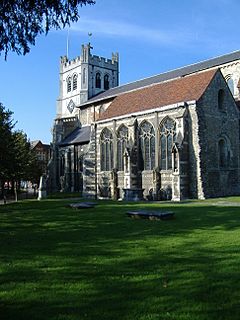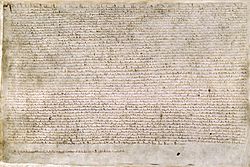Hugh de Neville facts for kids
Quick facts for kids
Hugh de Neville
|
|
|---|---|

The church at Waltham Abbey, where Hugh de Neville was buried
|
|
| Chief Forester of England | |
| In office 1198–1216 & 1224–1229/34 |
|
| Sheriff of Oxfordshire | |
| In office 1196–1199 |
|
| Sheriff of Essex and Sheriff of Hertfordshire | |
| In office 1197–1200 |
|
| Sheriff of Hampshire | |
| In office 1209 – c. 1213 |
|
| Sheriff of Lincolnshire | |
| In office 1227–1227 |
|
| Personal details | |
| Died | 1234 |
| Resting place | Waltham Abbey |
| Spouses | (1) Joan de Cornhill (2) Beatrice |
| Children | John de Neville Henry de Neville Herbert de Neville Joan |
Hugh de Neville (died 1234) was a very important official in England. He served as the Chief Forester for three different kings: Richard I, John, and Henry III. This meant he was in charge of all the royal forests and the special laws that applied to them. He also worked as a sheriff in several parts of England.
Hugh de Neville was connected to many other royal officials and even a bishop. He started his career working for Prince Richard, who later became King Richard I. When Richard became king, Hugh continued to serve him and even went with him on a big adventure called the Third Crusade.
After King Richard died in 1199, Hugh de Neville stayed in royal service under the new king, John. He became one of King John's close friends and often gambled with him. Hugh was even mentioned in the famous document called Magna Carta as one of King John's main advisors. Some people at the time thought he was one of King John's "bad advisors."
Hugh de Neville left King John's side when France invaded England in 1216. But he soon returned to support King John's son, Henry III, after Henry became king later that year. Hugh continued to serve the king until he died in 1234. However, he wasn't as powerful later in his life as he had been before.
Contents
Early Life and Royal Service
Hugh de Neville was the son of Ralph de Neville. His grandfather, Alan de Neville, was also a Chief Forester, so being in charge of forests ran in the family! Hugh had two brothers, Roger and William, who also worked for him or received land from the king.
The Neville family was well-connected. They were related to important people like Geoffrey de Neville, who was a royal chamberlain (a high-ranking servant), and Ralph Neville, who became a bishop. Hugh de Neville helped Ralph de Neville start his career, and they remained good friends.
Hugh de Neville began his career working for Prince Richard, who later became King Richard I. He also served Richard's father, King Henry II, managing some lands for him.
Adventures on the Third Crusade
Hugh de Neville went with Prince Richard on the Third Crusade, a big military journey to the Middle East. He was one of the brave knights who fought alongside King Richard on August 5, 1192. This was outside the city of Jaffa, where King Richard and a small group of knights fought off a surprise attack from Saladin's army. Hugh de Neville's stories about these events were used by a writer named Ralph of Coggeshall to record King Richard's actions during the Crusade.
Becoming a Sheriff
In 1194, Hugh de Neville gained control over Joan de Cornhill, a young woman who had inherited land. He married her four years later. Also in 1194, he was put in charge of the town of Marlborough.
In 1196, he became the Sheriff of Oxfordshire. A sheriff was like a chief law enforcement officer and administrator for a county. In 1197, he also became the Sheriff of Essex and Sheriff of Hertfordshire, holding these jobs until 1200.
Hugh de Neville as Chief Forester

In 1198, King Richard I made Hugh de Neville the Chief Forester. This was a very powerful job! The Chief Forester was one of the four most important officials in the kingdom. The others were the chief judge, the chancellor (who handled royal documents), and the treasurer (who managed money).
The Chief Forester was in charge of all the royal forests and made sure the special forest laws were followed. These laws were very strict and applied to huge areas of land, not just woodlands. By the late 1100s, about a quarter to a third of England was considered royal forest! Kings used these harsh laws to collect a lot of money from people. For example, in 1198, the forest laws brought in about £1,980, which was a huge amount of money back then.
Working for King John
Hugh de Neville continued to be Chief Forester under King John. He was often King John's partner in gambling games and frequently witnessed the king's official documents. King John also appointed him as Sheriff of Hampshire in 1210.
In 1210, King John fined Hugh de Neville a large sum of money (1,000 marks). This was because Hugh had allowed a bishop to enclose some hunting grounds without the king's permission. This was a serious offense against the royal forests. The fine was a warning from the king, but it was later cancelled.
Around 1213, Hugh de Neville seemed to lose some of the king's favor, though we don't know exactly why. He was fined again, this time 6,000 marks, for allowing two prisoners to escape and for other unknown reasons. The king later reduced this fine. In 1215, Hugh lost his job as Chief Forester.
He was present at Runnymede when Magna Carta was signed. This important document listed him as one of King John's advisors. However, a writer at the time, Roger of Wendover, called Hugh de Neville one of King John's "evil counsellors," meaning he thought Hugh gave the king bad advice.
Later Years and Service to Henry III
King John's way of ruling and his military defeats made many of his nobles unhappy. In 1215, a group of powerful nobles forced King John to agree to Magna Carta, which aimed to make the government fairer. But King John later got the Pope to cancel the charter. This led to a war, and the nobles invited Prince Louis of France to become the new king of England. Louis arrived with an army in May 1216.
Hugh de Neville joined the rebel nobles in 1216, after Prince Louis invaded England. Hugh even gave up Marlborough Castle, a royal castle he was in charge of, to Prince Louis. When King John heard about this, he took away all of Hugh de Neville's lands. Hugh's son, Herbert, also joined the rebels.
After King John died in October 1216, Hugh de Neville and his son made peace with the new king, Henry III, who was John's son. Both Hugh and his son got their lands back in 1217. Hugh slowly regained some of his old jobs. By 1224, he was once again the Chief Forester. However, he never had as much power and influence as he did when he worked for King John. He also served as Sheriff of Lincolnshire.
Family and Legacy
Hugh de Neville's first wife, Joan de Cornhill, died after 1224. He later married Beatrice, who was a widow. Hugh and Joan had at least three sons named John, Henry, and Herbert, and a daughter named Joan.
Hugh de Neville died in 1234. He was buried at Waltham Abbey, a church he had supported with gifts. He also gave gifts to other churches and priories.
Historians have different views on Hugh de Neville's importance. One historian, Sidney Painter, believed that Hugh de Neville, as Chief Forester, might have had the most real power among all the royal officials during King John's reign. Another historian, J. R. Maddicott, said that Hugh de Neville was in charge of "one of the most detested branches of royal administration," meaning people really disliked the forest laws he enforced.
Images for kids


